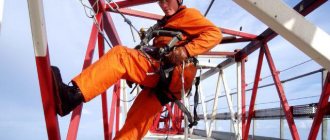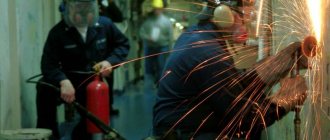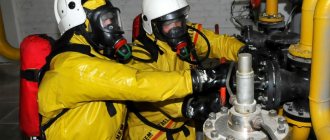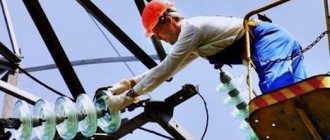What is a work permit for work in electrical installations?
In fact, this document is a kind of permission to carry out work of this type. As a rule, it includes exactly those types of work that this document allows to perform. The names of the specialists to whom the work is entrusted are indicated here. The team leader and those responsible for the work process are also noted.
In addition, the document contains information about safety measures and workplace preparation rules. For example, if some devices are turned off, this must be indicated in the document. In addition to disconnecting, you need to enter information about the grounding of specific objects.
A special form is used to complete the attire. The document is necessary in all situations when a specialist cannot simply come and do the necessary work. Responsible persons note in the work order all the manipulations carried out aimed at the safe performance of work. Each employee who is part of the team that will work in electrical installations is familiarized with the safety rules and methods of preparing the workplace.
What is the list of works
The main purpose of the outfit is to clearly display what kind of work specialists can do. The absence of this document is a gross violation of maintenance rules and regulations. Most often, a work permit is required for the following work:
- digging holes in the ground, the depth of which exceeds one and a half meters, and carrying out work in them;
- work related to digging the ground near energy networks, gas and oil pipes and various communications that are located underground;
- work aimed at repairing and strengthening some parts of buildings, as well as related to the demolition of various structures;
- construction and other work that is performed at height;
- restoring the functionality of hot water and steam pipelines;
- work carried out on buildings where there are no protective fences around the roof perimeter;
- transportation, lifting and lowering of large and heavy loads, if there are no devices necessary for working with such loads;
- repair of devices and equipment whose height exceeds two meters;
- work at height, such as repairing and maintaining lamp posts or cranes;
- work in a confined space of a small area;
- welding work associated with tanks, tunnels, reservoirs and other containers in which flammable substances were stored;
- repair of pipelines in which gas, steam or water passes under pressure;
- draining, transporting or other work with alkalis, acids, flammable liquids;
- work related to ventilation hoods, chemical laboratories, in rooms with hazardous materials and radioactive substances;
- cleaning containers in which cyanide compounds were stored;
- repairs on ammonia and oxygen compressors and pipelines;
- transportation of powerful pesticides;
- recycling of chemical industry waste, alkali metals and poisons;
- repair of installations on overhead power lines;
- work using a crane that has to work near power lines;
- performing hazardous work related to the gas system;
- work in premises associated with an increased risk of fires and explosions.
List of works
the following list of works can be displayed here :
- carrying out work on switchgear busbars;
- on a switched off electric motor or a mechanism connected to it;
- associated with electric motors having the same voltage, carrying out repairs in this device;
- execution of tasks on the switching device subject to its subsequent testing;
- relaying the cable that is connected to the network;
- performing functions in underground cable structures;
- testing work on electrical equipment;
- work in secondary circuits and relay protection devices;
- performing tasks with thermal automation objects;
- work related to existing electrical installations.
Rules for issuing a work permit
The law does not provide for the use of a single form for drawing up this document. For specific types of work, a special form is used. This is stated in regulations. In addition, such documents can be designed differently in different departments and workshops.
The absence of a single form is explained by the fact that in specific cases it is necessary to enter additional points that reflect the essence of the work in specific conditions. Columns can be added in accordance with internal orders and instructions.
Despite the fact that a fairly large number of varieties of outfits can be used, they all have the same purposes. In addition, their content remains the same. Also, the design rules are almost the same:
- the document must be completed before the start of hazardous work;
- the work order is issued precisely in the division of the enterprise in which these works are planned to be carried out;
- in a special journal that must be present in the company, a mark is placed indicating that the order has been issued;
- at the discretion of the responsible persons, the document is issued for one work shift, or for the entire period during which repair work is planned. In this case, the document is only extended for subsequent shifts, before each start. In this case, the work must be performed by only one team;
- the document must have two copies. All marks contained in it must be clearly legible. No corrections can be made here;
- if dangerous work is performed by two groups of specialists, each of them must receive a separate outfit. Moreover, foremen need to familiarize themselves with the activities that were specially designed for joint work;
- technological lines, structures and areas where hazardous work will be performed by the contract team must be transferred under the appropriate act. However, this is done if all work in this area is stopped. In the event that gas, electric or steam wires operate here, hazardous work cannot be carried out at the facilities;
- if it is planned to carry out work in close proximity to hidden and overhead communications, it will be necessary to coordinate their implementation in advance with the relevant enterprises. At the same time, in addition to the work order, the team of specialists must receive hidden communication diagrams and permitting documents.
How long is it issued?
A permit to carry out hazardous work is tied to a specific person and place. Particular attention should be paid to the fact for how long this document is valid. So, the permit must be in two copies. The specialists who will carry out the work receive one of them in their hands. The second is sent to the folder for storing work orders for uncompleted work. She is usually located in the control room.
As a rule, a new outfit must be issued for each shift. However, it is possible to issue a work order whose duration of work is quite long. This document is renewed before each work shift.
Registration procedure
Let's take a closer look at the order of filling out the work order :
- "Security measures have been agreed upon." The full name, position of the specialist and his signature who took these measures should be displayed here (most often the chief power engineer in the organization plays this role, it can also be the head of the service, etc.).
- "Company". The company where the work is planned to be carried out is displayed here.
- "Subdivision". Here the department in which they want to carry out the repairs is registered.
- “Permission work order.” This line contains a special number designating this object. As a rule, almost every company keeps a journal in which all work carried out in the selected area is noted.
- "To the work manager." At this point, you need to write down the full name and received electrical safety group of the specialist, who is approved by the head of the prescribed work in accordance with the issued permit. As a rule, he is appointed by the worker involved in drawing up the work order.
- "To the one who allows." Here the full name and received rank of the worker are displayed, who grants access to the specified team to perform their direct work (his role is often played by a person from the operations department who is involved in management in this field of activity).
- "With members of the brigade." The full names and electrical safety groups of the employees who will form the team are displayed here.
- "Guaranteed." The task that needs to be completed in this outfit is displayed here.
- “Start work.” Here you need to display the day on which you plan to start work and the exact time.
- “Finish the work.” The expiration dates for the official validity of the document are displayed here. If the work is delayed, there will be a need to extend the permit (there is a special column at the bottom of the document for this).
- "Separate instructions." Listed here are a number of additional measures to ensure safety in the workplace. This may include fencing the work area, posting warning signs, and enforcing strict compliance with fire safety measures. In addition, this line specifies some permissions intended for the work manager.
- “I gave out the outfit.” Here you need to write down the day and exact time the permit was issued, as well as the name and position of the specialist who issued it.
- “The outfit was extended by:.” Here you need to indicate the date and time until which the work order was extended, and also write down the name and position of the person who did it.
After the main lines have been filled out, there is a need to draw up table No. 1 . It will display measures to prepare the workplace. The table is divided into two parts:
- The first contains the names of all electrical installations where disconnection or grounding will occur.
- The second specifies all devices that must be disconnected and grounded.
The front side of the document is completed. It is usually filled out by the person who issues the permit. Now it remains to draw up the reverse side, for which the workers preparing the workplace are responsible.
In Table No. 2 “Permission to prepare workplaces and for admission,” an entry is made by specialists who are preparing the site of the planned work.
- Column 1 displays the position held and the full name of the employee who issued the permit.
- Column 2 records the date and time of the issued permit.
- Column 3 contains the painting.
The table is followed by the line “Workplaces are registered. Remained under voltage:” , in which it is required to record all adjacent elements to the object being repaired that are still connected to voltage.
When filling out table No. 3 “Instruction of team members during initial admission”, all instructions on measures aimed at improving safety that must be carried out unconditionally during working hours are displayed.
Provided that the permit will be issued for a couple of days, table No. 4 “Daily permit to work and its completion” records the daily time at which repair or maintenance work begins and when it is completed.
If there is a need to replace a team member, then this data is displayed in table No. 5 “Daily admission to work and its completion .
When all assigned tasks are completed, the completion of the work will need to be recorded in this document. To do this, the appointed team leader writes down the initials and position of the person to whom he reported on the fulfillment of all set goals, after which he enters the time and date of completion of the work.
Shelf life
After the hazardous work has been completed, the document is moved to the folder with work orders for the work performed. It needs to be stored here for one month. After this period, the document can be disposed of. If an unforeseen situation arises in which damage to the property or health of an employee was caused, an investigation begins. A permit must be attached to this case. In this case, the document is stored for 45 years.
The company's charter may provide for mandatory storage of these work orders. In this case, the documents, after being stored for a month, are sent to the archive.
Blog about energy
Despite the fact that the document is more than ten years old, it is still constantly used when preparing production orders.
The document describes recommendations for filling out each item of the permit for work on thermal mechanical equipment.
General provisions
1.1. These recommendations have been developed on the basis of the current “Safety Rules for the operation of thermal and mechanical equipment of power plants and heating networks.”
1.2. Entries in the work permit (hereinafter referred to as the “work order”) must be legible. Filling out the work order with a pencil and correcting the text are not allowed.
1.3. The work order numbering system is established by the head of the enterprise.
1.4. When specifying dates, write the day, month and last two digits indicating the year, for example: 07/12/01 or 12/03/02. The time of day is indicated as follows: 08-40 or 23-15.
1.5. In addition to the surnames and initials of the persons mentioned in the work order, their position, qualification category and, if necessary under working conditions, the electrical safety group are indicated.
1.6. The work order specifies the dispatcher names (designations) of the equipment, incl. electrical equipment and shut-off valves, in accordance with technological diagrams, it is allowed to use abbreviated designations accepted in the industry, for example, “LDPE, HDPE”. However, "acid tank No. 3" should be indicated. ,
but not “tank number 3”.
1.7. In cases where there are insufficient lines in the work order form, it is allowed to draw up attachments that will be an integral part of the work order, including:
Appendix 1 to work order No.... “List of team members” or
Appendix 1 to the general order No.... “List of work producers”, which indicates the serial number, surname, etc. o., position and rank (for workers). The list is signed by the work supervisor.
Appendix 2 to work order No.... “It is necessary to ensure safe conditions,” which is signed by the issuer of the work order.
Appendix 3 to work order No.... “Special conditions”, which is signed by the work manager.
1.8. Proposals for the formulation of measures for preparing workplaces in the lines “To ensure safe conditions it is necessary” and “Special conditions” are drawn up in imperative form, for example, “turn off ...”, “close valve No. ...”, “open valve No. ...”, etc. P.
1.9. Entries in the work order must be specific, not allowing for double interpretation. It is not allowed to indicate as measures “comply with safety regulations”, “comply with safety regulations”, “do not violate safety rules”, etc.
1.10. When issuing a work order, in the lines that do not need to be filled in, “not assigned”, “not provided”, etc. are written.
1.11. When performing work on the thermomechanical part of TAI devices, a work order provided for by PTB(t) is issued; if work is carried out in the electrical part of TAI devices, then a work permit is issued in accordance with PTB(e).
1.12. Registration of targeted briefings is carried out in the manner established at the enterprise in accordance with the requirements of the DGIES RAO UES of Russia on this issue.
1.13. It is allowed to prepare work orders using a PC.
Filling out the work order pages
2.1. The line “Enterprise” indicates the officially accepted abbreviated name of the enterprise.
2.2. The line “Division” indicates the officially accepted abbreviated name of the workshop, site, district of heating networks, etc.
2.3. The line “To the work manager” is filled in in accordance with the interlinear text. When appointing a specialist from a third-party organization as a work manager, after indicating his position, the name of this organization (enterprise) is indicated.
2.4. In the line “Producer of the work (supervisor)” the surname and name are indicated. o., profession or position, rank of work producer. When appointing an observer, the same is indicated in parentheses after the information about the work contractor.
When appointing several work providers for a common work order, the line is filled out taking into account clause 1.7 of these Recommendations. In this case, each work producer puts a signature next to his name.
2.5. In the line “With brigade members,” the initial number of brigade members in the order and intermediate order or the number of brigades in the general order is indicated in numbers. Further, in the work order, intermediate work order, the members of the team are listed, indicating the rank, position (profession) and electrical safety group in accordance with the interlinear text. The general order indicates the number of brigades, and the number of brigades, surname, etc. o, categories and, if necessary, electrical safety group are indicated in intermediate orders.
If there is not enough space in the line, an entry is made “in accordance with Appendix 1 to this order” (see paragraph 1.7 of the Recommendations).
2.6. In the “Entrusted” line, the type of repair (current, medium, major) or type of work (elimination of a defect, installation, adjustment, etc.) and, further, the dispatch number of the equipment or its designation according to the technological diagram, the place of work of the team are sequentially indicated.
2.7. In the lines “beginning and completion of work” the date and time of the beginning and end of work on this work order are indicated, with the date in the form “07. 11.01”, time – in the form “07-30” or “20-40”.
2.8. In the line “To ensure safe conditions it is necessary”:
2.8.1. The work order and general work order indicate the following requirements:
- on bringing the equipment into a state in which work can be carried out, and on carrying out the necessary operations with shut-off valves and devices that ensure shutdown of the equipment, as well as emptying vessels and pipelines of gas, steam, hot and cold water, chemicals, fuel oil and etc.;
- on checking the installation of plugs on pipelines in front of the valves;
- about turning off electric motors of mechanisms and drives of fittings with grounding of supply cables or their disconnection;
- about closing the steering wheels by locking the fittings with chains or other locking devices;
- on checking the disconnection of couplings connecting mechanisms to engines;
- about ventilation of vessels, boiler furnaces, underground structures and other confined spaces;
- on checking the environment for sufficiency of oxygen and absence of hydrogen, methane, carbon dioxide, etc.;
- about fire safety;
- on the installation of posters and safety signs “Do not open - people are working” on valves and shut-off valves; “Do not close - people are working” on the valves of open drains; “Do not turn on - people are working” on the control keys for the electric drives of the shutdown valves;
- other measures at the discretion of the issuer of the work order necessary to prepare the workplace.
If there is not enough space in the work order form, the line “To ensure safe conditions is necessary” should be supplemented with the words “perform measures in accordance with Appendix 2 to this work order” and safety measures should be indicated in this appendix.
2.8.2. The intermediate order states:
- “boiler No.... (or other equipment) was put out for repair according to the general order No...”, while a listing of the activities performed by the operating personnel to bring the equipment out for repair, provided for in the general order, is not required;
- requirements for preparing the workplace for direct work on the intermediate work, including: installation of ladders and special fences; installation and use of air-suffocating units; installation of additional lamps; use of gas masks, safety belts, overalls, safety equipment;
- safety measures in the process of equipment repair, an approximate list of which is given in clause 2.9.
2.9. The lines “Special conditions” are filled in by the work manager only in the work order (not required in the general and intermediate work orders), and if necessary, depending on the type of work and the state of the workplace, the following is indicated:
- direct supervision of the work manager for all or part of the work;
- factory and local instructions and technological documentation (technological map, PPR, manual, etc.), which must be used during work;
- procedure for using lifting machines;
- measures to protect workers from burns and high temperatures;
- fencing the workplace, clearing snow and ice from approaches to equipment and open hatches;
- safety measures when working in underground structures;
- measures when working on oil systems;
- measures to observe personal hygiene rules when working with Ivvi-ol-3 oil and other harmful and dangerous substances;
- safety measures for chemical cleaning of equipment;
- safety measures when using devices with radioactive elements;
- ventilation of premises, underground structures and vessels;
- safety measures during steeplejacking and when working at heights;
- appointment of an observer when working in tanks and closed containers;
- the time workers spend in underground structures, closed tanks, gas ducts, etc., as well as the time of compulsory rest;
- other safety measures at the discretion of the work manager.
The text of the line “Special conditions” is confirmed by the signature of the work manager in the same line.
If there is not enough space in the “Special conditions” line, the entry “carried out in accordance with Appendix 3 to this order” is made and the necessary measures are indicated in this appendix.
2.10. The line “Issued the order” does not require any explanation.
Note:
The work order for hot work is issued by the head of the workshop, and for fire hazardous equipment, with a visa from the head of the workshop, the chief engineer of the enterprise. When performing hot work on an intermediate work order, in addition to the work manager on the general work order, he is endorsed by the head of the workshop. In both cases, the workshop manager’s signature is placed in the line “Issued the order.”
2.11. The line “Work order extended” is filled in by the person who has the right to issue orders.
2.12. In the line “Conditions for the work have been fulfilled,” the senior duty personnel of the workshop (unit) or the responsible person of the operational (operational and repair) personnel of the district (section) of the heating network confirms with their signature, indicating the date and time, the implementation of the activities prescribed by the order.
In the intermediate work order, the signature in this line is placed by the work manager for the intermediate work order.
2.13. The line “Remains in operation” should indicate equipment located near the place of work and under voltage, under pressure, at high temperatures, as well as filled with gas, explosive and fire hazardous, etc.
2.14. In the lines “On-duty personnel of other workshops” the signature of the on-duty personnel of the workshops that performed the activities specified in the work order is placed, indicating their position and surname; when messages are sent by telephone, this is confirmed by the signature of the shift manager of the workshop who received this message.
2.15. In the line “Note on the permission of the power plant shift supervisor (duty dispatcher),” a record is made of the permission to carry out work by the station shift supervisor (duty dispatcher) in person or, if the permission is transmitted by telephone, is confirmed by the signature of the workshop shift supervisor.
Note.
The permission of the power plant shift supervisor (dispatcher of the heating network enterprise) is required in cases where equipment under his operational control is taken out for repair, as well as in cases of work under general orders and in several sections of heating networks. In other cases, “not required” is written in this line.
2.16. In the lines “Responsible person of the duty personnel” and “supervisor of work on the intermediate work order”, when working on the work order and on the general work order, the last line is crossed out; indicating the position and surname, the signature of the responsible person of the duty personnel is affixed. When working on an intermediate work order, the first line is crossed out and the signature of the work manager is indicated indicating his position and surname .
The lines are filled in after checking the correct preparation of the workplace.
2.17. The lines after the words “Compliance with the conditions have been checked...” are filled in after the workplace has been accepted from the person accepting it and the compliance with the safety measures specified in the work order has been verified. At the same time, the work manager and the work performer put their signatures; When working on a general work order, the signatures of the work producers in this work order are not required.
The observer signs the corresponding line of the work order after the signature of the work contractor.
After checking the preparation of workplaces, admission to work and execution of the work order, the permitter, in the presence of the manager, the work manager and the supervisor, hangs a poster “Work here!” at the place of work.
2.18. The table “Registration of daily admission...” for admission by work order and intermediate work order is drawn up with the signatures of the permitter and the work foreman (supervisor), and after completion of the work - with the signatures in the same table of the responsible person of the duty personnel and the work foreman (observer); in the general order the table is not filled out.
2.19. Inscriptions on the margins of the order on the front side at the top of the page are made in the following cases:
- when approving a work order by the chief engineer of the enterprise in case of equipment shutdown by one valve at a water temperature of 45 °C or more;
- when the work order is endorsed by the work manager for the general work order, if the work is carried out on equipment belonging to other workshops and it is located in the coverage area of the general work order;
- if permitted, include a flaw detectorist in the work order (signed by the head of the unit on whose staff this employee is);
- when a work order is endorsed by the shift supervisor of a workshop in the case of work performed on equipment belonging to other workshops, but associated with thermal-mechanical equipment or located on thermal power plants and near them (clause 4.1.10 PTB TMO);
- when a work order is endorsed by the workshop manager in case of hot work being performed on equipment belonging to other workshops;
- in other necessary cases.
| AGREED: Chief Labor Safety Inspector - Head of the Safety Department of DIGES RAO "UES of Russia" Yu.I. Zhukov10.03.2001 | I CONFIRM: Chief Engineer of the Representative Office of RAO UES of Russia for the management of joint stock companies of the Ural part of Russia "Uralenergo" P.B. Pivnik 03/23/2006 |
The outfit's uniform was taken from production. It is slightly different from the one given in the labor protection rules. In particular, in the form from the rules there is no table for registering target instruction. This table is present in the work order forms for gas-hazardous work and high-risk work. However, the rules require instructions before starting work, so this table is also included in this form. Enjoy it, friends!
Share with your friends
- Click here to share content on Facebook. (Opens in a new window)
- Click to share on Twitter (Opens in new window)
- Click to share on LinkedIn (Opens in new window)
- Click to share on Telegram (Opens in new window)
- Click to share on WhatsApp (Opens in new window)
- Click to share on Skype (Opens in new window)
- More
- Send this to a friend (Opens in new window)
- Click to print (Opens in new window)
Similar
How to obtain admission
At the top you must indicate the name of the company that has an employee receiving the permit. If the employee is registered in a certain department, he must also be indicated. In the middle of the page you need to not only enter the name of the document, but also put down its number corresponding to the number of the internal circulation of documents.
Then it is worth noting the workers who are responsible for working in the electrical installation. Not only the leaders of the brigade are indicated, but also all its members. It is worth noting not only the names of the employees, but also their access groups. There are often situations when the employee appointed responsible for this procedure does not personally take part in the work. This fact must also be reflected in the document. The work order must indicate the exact time of the work that is planned to be carried out.
Below there is a special table designed to show the measures that have been taken to carry out safe work. Clearly indicate in which electrical installation the work will be carried out. The document contains a special column designed to indicate communication units that need to be grounded or de-energized. If there are additional instructions regarding safety precautions, they should be entered below the table.
At the bottom of the document is the date of its issue and the exact time. The work order is also signed by the employee who is responsible for issuing it.
The most necessary regulations
| Document | Will help you |
| Order of the Ministry of Labor of Russia dated July 24, 2013 No. 328n | Understand how to formalize and organize work in electrical installations according to work permits |
| Decree of the Government of the Russian Federation of February 24, 2009 No. 160 | Clarify the rules for carrying out work in the security zone of the power line |
Distribution territories
A separate paragraph of the rules stipulates the conditions for operations in the area of high-voltage lines. The permit for work in electrical installations on the territory of switchgears is issued by an employee who belongs to the operational personnel servicing overhead lines. He also instructs team members if work is carried out on the end support. RU maintenance personnel are required to accompany them to it.
Portals of open switchgears and indoor switchgear buildings are repaired by workers who receive permission from the permitting employee from among the operational personnel who directly service the equipment itself.
High-voltage lines are inspected according to one permit. If the overhead line is multi-circuit, then a work permit is issued separately for each circuit. The exception is:
1. Relieve voltage from the entire high-voltage line.
2. Repair and inspection of overhead lines at their switching points.
3. Disconnection of transformer points or their complete units.
4. Prevention on high-voltage lines with non-current-carrying parts or those that do not require shutdown.
Special work in electrical installations for the repair of cable seals and end couplings in the switchgear is permitted according to a work order issued by the operating personnel directly servicing the switchgear.
Organizational events
The safety of work in electrical installations is stipulated in the fifth section of the rules. It talks about the organizational measures necessary to carry out repairs and preventive inspections by administrative-technical, operational, maintenance and operational-repair personnel, depending on the qualification group. It is assigned after training and testing of knowledge in specialized institutions.
The rules for working in electrical installations refer to the issuance of a permit specifically as an organizational event. The fifth section states that, according to the terms of reference, the form is filled out by the person responsible for the safe performance of work. According to the rules, this is:
1. Manager approving the list.
2. The specialist who issues the permit.
3. The employee giving the order.
4. The person who authorizes the preparation of the workplace.
5. Observer.
6. Work producer.
A work permit for work in electrical installations or an order has the right to issue personnel of a certain qualification. There are some nuances here. Thus, work in electrical installations up to 1000 V is allowed to persons with group IV, over 1000 V - to those with group V.
Structure of the new Rules
The content of the annex to Law No. 328n, naturally, has undergone some changes, but the names and meaning of the main sections have remained the same. This also applies to the content of the chapters, which stipulate the safety of work in electrical installations for which a permit is issued. The rules stipulate that it should occur after crew members have been given instructions on labor protection for workers, according to their specialties.
The first three sections of the appendix to Law No. 328n stipulate the scope of its application, requirements for personnel, operational maintenance and inspection of equipment and do not mention work on the side in electrical installations. Detailed conditions for issuance, registration procedure, qualifications of the admitter, observer and manufacturers are set out in chapters starting from V.
Communication devices
Preparation of workplaces for carrying out work in communication devices located on the territory of the reactor plant is carried out by operational personnel from among those servicing this device.
Technological and dispatch management specialists have the right to issue a permit, which does not negate the possibility of authorizing repairs, inspections and preventive maintenance by those performing control over the switchgear.
The exception is work on high-frequency suppressors and coupling capacitors. In these cases, only the personnel servicing the plant has the right to issue a permit.
Order on preparation of workplaces
The work permit for work in electrical installations contains not only information about the time and place of their implementation, but also notes on permission to prepare sites for inspection, repair, and preventive maintenance. Operating personnel with qualification group IV or V make an appropriate entry on the form and are responsible for:
1. Safe disconnection, switching on and grounding of equipment.
2. Clear definition of the time interval for work.
3. Indication of location.
4. Accounting for the number of teams.
5. Receiving information about the end of actions.
6. Accuracy and correctness of given commands.
The rules allow permission to be issued to administrative and technical personnel with the caveat that this must be approved in writing by the head of the enterprise.
Permit, leader, observer, producer
The rules for working in electrical installations contain certain requirements for persons who are responsible managers. They are appointed in cases where equipment repair and maintenance is carried out:
1. When using lifting machines and mechanisms.
2. In case of power failure.
3. When working with cable communication lines in areas of traffic and communications.
4. When replacing parts of high-voltage line supports, as well as their dismantling and installation.
5. When connecting a newly introduced overhead line.
6. When working under induced voltage.
7. In some other cases.
The right to authorize repairs, inspections and preventative maintenance has a person from the staff with a qualification group of at least IV-V - permissible. His responsibilities include assessing the safety measures taken during the preparation of workplaces or their direct preparation, and instructing team members.
The manufacturer issuing a work permit must have group IV when performing maintenance in electrical installations with voltages up to 1000 V, V - over 1000. He is appointed from the operating personnel and is responsible for:
1. Completeness and clarity of targeted briefing to team members.
2. Permission to work in electrical installations.
3. Correct use, serviceability and availability of equipment, tools, collective and individual PPE.
4. Presence of fencing and prohibition signs on site.
5. Full compliance with labor protection rules.
The observer must be appointed from among personnel with a qualification group of at least III. The need for the presence of such an employee arises if all members of the team do not have the necessary qualifications in electrical safety. The duties of the observer include:
1. Ensuring safety.
2. Safety and presence of warning and prohibiting safety signs, posters, fences, grounding, locking devices.
3. Monitoring the compliance of the workplace with the developed measures.
4. Completeness of targeted instruction.
Conditions for issuing a work order in one copy
Equipment with voltages over 1000 V is allowed to be repaired and inspected with one permit, provided that it is de-energized. In this case, entry into nearby electrical installations is prohibited. If the voltage in them is up to 1000 V, then all live parts may not be disconnected.
It is also allowed to issue a work permit in one copy for work in electrical installations in distribution boards, busbars and some other parts. The voltage in them must be less than 1000 V. In this case, the equipment must also be de-energized.
The rules allow filling out the form for several or one workplace, in cases where their electrical circuits or equipment have the same name, purpose, and voltage.
Also, work along with electrical installations can be carried out when registering one copy in the following cases:
1. When relaying or laying control and power cables, checking protection devices, checking the blocking of electrical automation, testing, blocking communications or telemechanics.
2. During repair work in switching devices.
3. When inspecting an individual cable in a well, tunnel, manifold, pit or trench.
4. When repairing no more than two cables, if it is carried out in two or one pit and one switchgear. At the same time, supervision of the working team by the work producer must be ensured.
1. Tightening contact connections. The work permit for work on several electrical installations can be written out in one copy, if they are of the same type, and the sequence is consistent, the equipment performs the functions of converting and distributing electricity, that is, it is located in a substation. According to the rules, these include:
2. Wiping the insulators.
3. Adding oil and taking samples.
4. Switching transformer windings.
5. Checking insulators with a rod, electrical automation devices, measuring instruments, relay protection.
This is not high-risk work. In this case, the work permit is issued by filling out the appropriate column for each substation.










